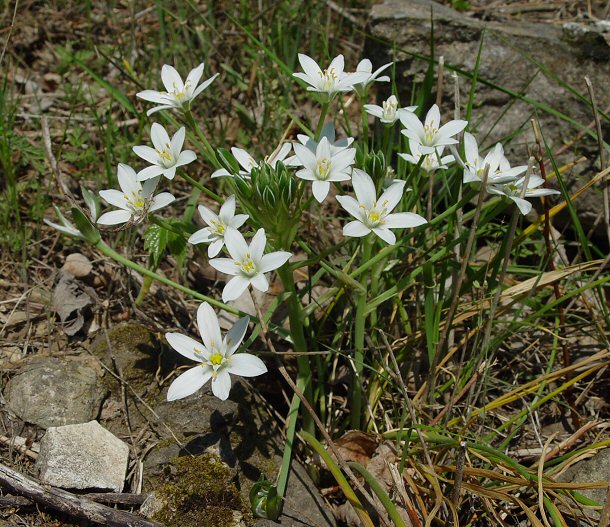Ornithogalum umbellatum L.
Star Of Bethlehem

Introduced
CC = *
CW = 3
MOC = 47
© DETenaglia
Ornithogalum umbellatum L.Star Of Bethlehem | |
 |
Introduced CC = * CW = 3 MOC = 47 |
© DETenaglia |
|
Family - Liliaceae Habit - Perennial forb, glabrous, from a bulb covered by a membranous to papery, smooth, outer coat, lacking the odor of onion or garlic. Stems - Erect, to 35 cm, glabrous, 4 mm in diameter, unbranched below the inflorescence. Leaves - Basal, 3-15, 6-30 cm long, 2-5 mm broad, linear, flat, grasslike, entire, glabrous, with a light green to whitish midrib on the upper surface. Inflorescence - Terminal racemes of 3-12 flowers, with leaflike bracts at the nodes. Lower flower stalks 2-6 cm long, the flowers ascending.
Flowers - Perianth 1.5-2.0 cm long. Tepals 6, white above, white with green stripe below, glabrous, free, oblong to linear. Stamens 6, with the filaments flattened, not tapering above the middle, extending past the attachment points of the anthers as 2 broad, shallowly triangular lobes. Anthers yellow, 2.5 cm long, 1.2 mm broad. Ovaries superior, longer than the styles, with 6 ridges, 3-locular, many seeded, placentation axile. Style 1, 2.5-3 mm long, white, glabrous. Flowers highly nectariferous.
Fruits - Ovoid to obovoid, bluntly trigonous capsules with few to no viable seeds.
Flowering - April - June. Habitat - Forests, gravel bars, pastures, crop fields, lawns, roadsides, railroads, and other disturbed areas. Sometimes cultivated and escaping. Origin - Native to Europe. Lookalikes - O. nutans. Other info. - This is a striking species, with showy flowers almost shining in their whiteness. The plant's range in Missouri is widely scattered. Although not particularly common, it can form populations of thousands of plants under favorable conditions. Crop fields in Warren County seem particularly susceptible to infestations of this species. In some areas it is considered invasive, though this property seems highly location dependent. Its U.S. distribution is likewise scattered, ranging mostly to the east of Missouri. The plant is easily recognized by its brilliant white flowers and grasslike leaves. It can be distinguished from the much rarer O. nutans by its longer flower stalks. Photographs taken by Tom's Creek, NC., 4-20-03, and near Charrette Creek, Warren County, MO., 4-17-04 (DETenaglia); also near Treloar, Warren County, MO, 5-13-2013, 5-2-2020, and 4-22-2022 (SRTurner). |